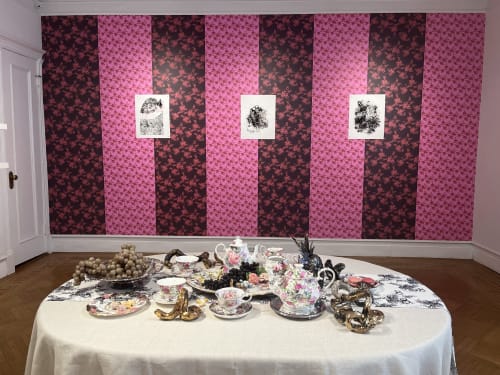And the Living is Easy : Sharon Norwood and Sheldon Scott
And the Living is Easy is a presentation of works by multidisciplinary artists Sharon Norwood and Sheldon Scott. Both artists explore ideas around leisure, creating objects that remind the viewer of the ways in which we delight in creature comforts imbued with history and an intimate relationship to the body and the radicality of rest.
The title is an adaptation of a lyric from the song Summertime from the opera Porgy and Bess (1935). The opera is set in Charleston, South Carolina in a community of Gullah Geechee peoples. Those who identify as Gullah Geechee are part of a maroon culture whose ancestry can be traced to West Africa and a history of resistance to institutional slavery in the U.S. sea islands. By contrast, the lyrics and music for Summertime are romantic; evocative of the hazy and languid summer months in the Deep South.
And the Living is Easy is a presentation of works by multidisciplinary artists Sharon Norwood and Sheldon Scott. Both artists explore ideas around leisure, creating objects that remind the viewer of the ways in which we delight in creature comforts imbued with history and an intimate relationship to the body and the radicality of rest.
The title is an adaptation of a lyric from the song Summertime from the opera Porgy and Bess (1935). The opera is set in Charleston, South Carolina in a community of Gullah Geechee peoples. Those who identify as Gullah Geechee are part of a maroon culture whose ancestry can be traced to West Africa and a history of resistance to institutional slavery in the U.S. sea islands. By contrast, the lyrics and music for Summertime are romantic; evocative of the hazy and languid summer months in the Deep South.
Sharon Norwood (lives and works in Savannah, Georgia) works across disciplines including ceramics, drawing, installation, fiber arts, and sculpture. The sculptures are porcelain objects including teapots, cups and saucers often with classical floral motifs. The works are layered with drawings that trouble the line between abstraction and figuration recalling strands of Black hair. The drawings animate and highlight the relationship between tea as a commodity and Blackness, leisure, and labor. Born in Kingston, Jamaica, and raised in Toronto, Canada, Norwood uses a technique to trace meaning related to her own story at the intersection of her Caribbean heritage and colonialism. Implicit in her mark making and the viewer’s reading of the works is the residual history of the objects.
Norwood’s work is included in the collections of the Gardiner Museum and the National Museum for Women in the Arts. Her sculptural works were recently included in the book Contemporary Black American Ceramic Artists (Schiffer Craft, 2022) and an upcoming solo exhibition at the Telfair Museum in Savannah, Georgia.
Sheldon Scott (lives and works in Washington, D.C.) works primarily with sculpture and performance. In his recent body of work, the artist is exploring a type of hammock that is an integral part of the culture of his birthplace, Pawleys Island, South Carolina. Drawing on another connection to the title and its provenance, Pawleys Island is home to a coastal community that identifies as Gullah Geeche from which Scott is descended. Scott's handmade hammocks are soft sculptures embellished with sequins, paint, and other materials. The sculptures are also the site of new performance work in which the artist explores the implications of rest and masculinity.
Scott was the first performance artist to become a finalist in the Outwin Boucher Portrait competition in 2019. His work was included in the group exhibition at the National Portrait Gallery in Washington, D.C. His work is currently on view at the Nasher Museum of Art at Duke University in the show Spirit in the Land.
While distinct in materiality, works by Norwood and Scott share a kinship of leisure both visually and historically. Visitors are invited to consider these objects within the context of the project space and how they function in interior and exterior landscapes.

